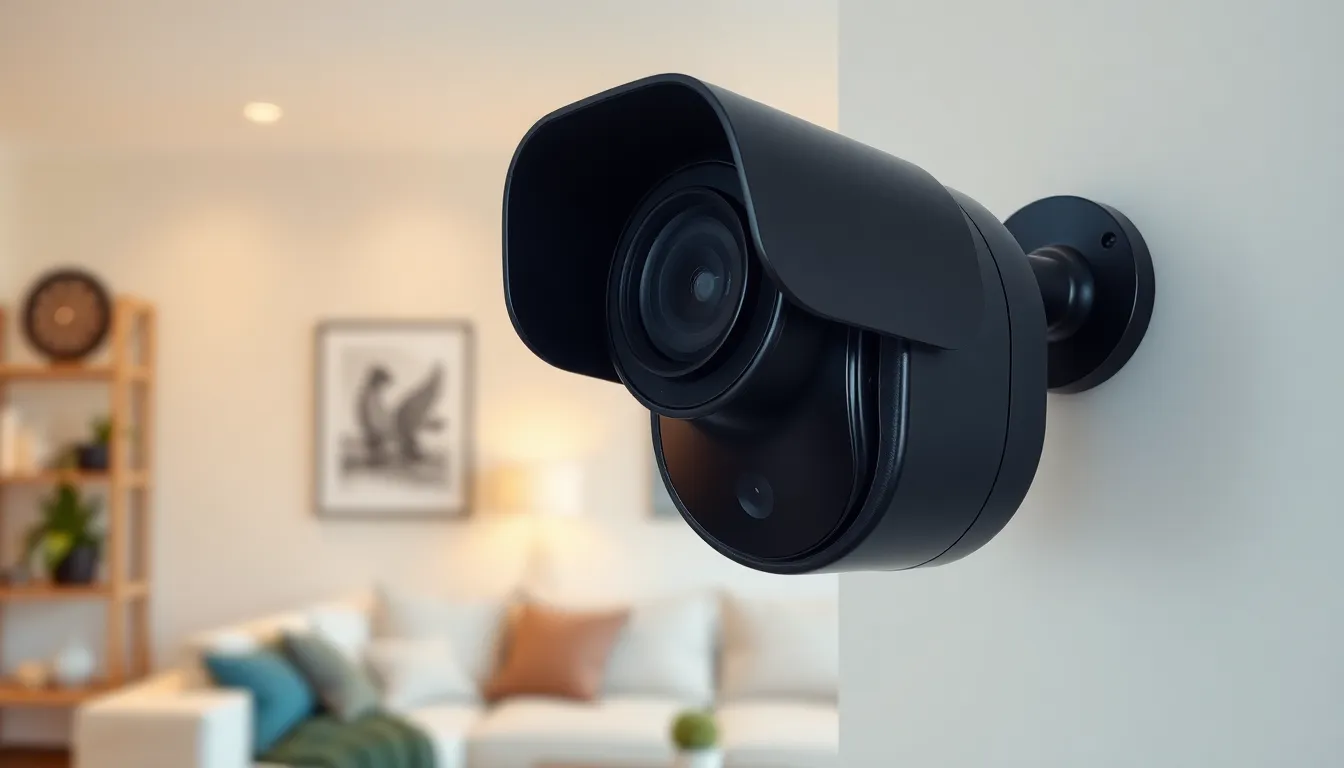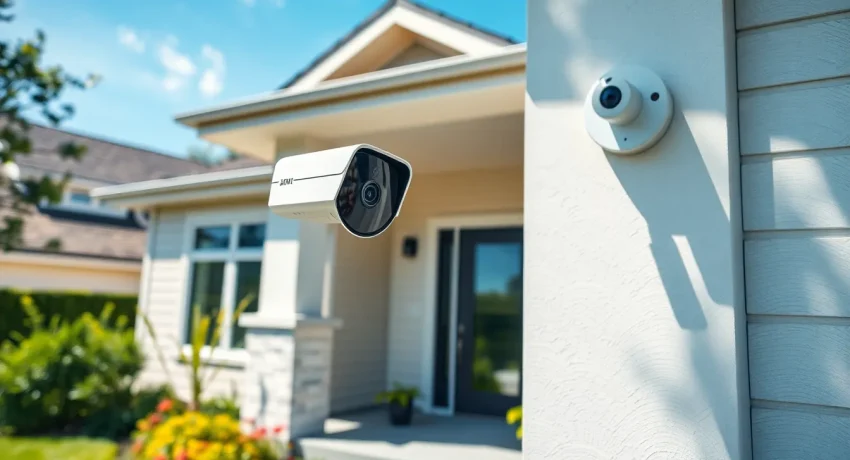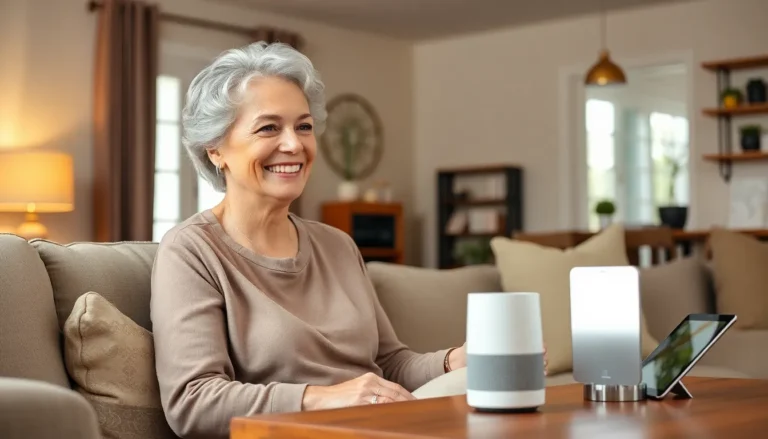Table of Contents
ToggleIn today’s fast-paced world, ensuring home security has never been more crucial. Smart home security cameras have emerged as a vital tool for homeowners seeking peace of mind. These devices not only monitor properties but also integrate seamlessly with other smart technologies, creating a comprehensive security ecosystem.
With advanced features like live streaming, motion detection, and cloud storage, smart cameras offer both convenience and protection. They empower homeowners to keep an eye on their property from anywhere, whether it’s through a smartphone app or a smart display. As technology continues to evolve, these cameras are becoming more accessible and user-friendly, making home security a priority for everyone.
Overview Of Smart Home Security Cameras
Smart home security cameras offer advanced monitoring solutions for properties. These devices capture high-definition video, providing clear surveillance that enables homeowners to keep an eye on their surroundings. Smart cameras feature integrated motion detection, sending alerts when movement occurs, allowing immediate responses to potential threats.
Smart cameras connect to Wi-Fi networks, enabling remote access through smartphones or tablets. Users can view live feeds or recorded footage from anywhere, ensuring constant awareness of their home environment. Many models support two-way audio, facilitating communication between the homeowner and guests or potential intruders.
In addition to video capabilities, smart security cameras often include cloud storage options. This storage allows users to save and retrieve footage without needing physical storage devices. Security features are enhanced through compatibility with other smart devices, such as alarms and smart locks.
Several types of smart home security cameras exist, including indoor, outdoor, and doorbell cameras. Indoor cameras monitor activity inside the home, providing peace of mind for families with children or pets. Outdoor cameras protect exterior areas, deterring burglars with visible surveillance. Doorbell cameras combine the functionality of traditional doorbells with video monitoring, adding an extra layer of security at entry points.
Smart home security cameras play a crucial role in modern home protection strategies. Their advanced features, ease of use, and integration with broader smart home systems make them indispensable for maintaining safety and security.
Key Features To Look For

When selecting a smart home security camera, specific features are vital for ensuring effective surveillance. Understanding these key elements will help homeowners choose the right device for their security needs.
Resolution and Image Quality
Resolution directly impacts the clarity of recorded footage. Look for cameras supporting at least 1080p HD resolution for sharp images. Higher resolutions like 4MP or 4K provide even greater detail, beneficial for identifying faces or license plates. Image quality also depends on sensor technology, which enhances low-light performance and reduces graininess. Consider cameras featuring wide-angle lenses, as they expand monitoring areas, reducing blind spots.
Night Vision Capabilities
Night vision ensures monitoring continues after dark. Infrared (IR) technology allows cameras to deliver clear images in low-light conditions, typically up to 30 feet. Some models offer color night vision, providing better detail than traditional black-and-white footage. Testing indoor and outdoor capabilities matters, as different environments may impact night vision performance.
Storage Options
Storage options influence how footage is saved and accessed. Many cameras use cloud storage for seamless access to recorded clips, often requiring a subscription for significant storage capacity. Local storage alternatives, such as microSD cards, allow users to save footage directly on the device. Hybrid systems enable both cloud and local storage, providing flexibility for users. Always confirm storage duration and retrieval processes when selecting storage solutions.
Types Of Smart Home Security Cameras
Smart home security cameras come in various types, each designed for specific monitoring needs. Understanding these types helps homeowners choose the right solution for their security requirements.
Indoor Cameras
Indoor cameras monitor interior spaces, enhancing home security from within. They typically feature high-definition video quality for detailed footage and often include wide-angle lenses to cover more area. Homeowners can use these cameras for various purposes, such as monitoring children, pets, or ensuring security when away. Many indoor cameras support two-way audio, allowing real-time communication with individuals present in the area. Some models are equipped with advanced features like facial recognition and activity zones, which help in minimizing false alerts by focusing on specific areas of interest.
Outdoor Cameras
Outdoor cameras are designed for external monitoring, offering robust features to withstand varying weather conditions. They often come with weatherproof housings and high-resolution video capabilities for clear surveillance. Outdoor cameras typically have enhanced night vision options, utilizing infrared technology to ensure visibility during dark hours. Motion detection alerts notify homeowners of activity in real-time, and many models can pan, tilt, or zoom for a broader field of view. Some outdoor cameras integrate seamlessly with other smart home devices, offering comprehensive security coverage. Placement options include mounting on walls or utilizing pole installations for optimal vantage points.
Popular Smart Home Security Camera Brands
Several brands dominate the smart home security camera market, each offering unique features and capabilities tailored to various needs and preferences.
Brand A Review
Brand A stands out for its high-quality image resolution and advanced motion detection technology. This brand’s cameras typically feature 1080p HD resolution, ensuring clear video footage. The integration of night vision capabilities enhances security during low-light conditions, while two-way audio enables real-time communication. Smart features, such as customizable activity zones and push notifications, allow homeowners to fine-tune their security settings for optimal protection. Cloud storage options provide an accessible way to retrieve footage when necessary.
Brand B Review
Brand B specializes in outdoor cameras designed for robust security solutions. These models boast weatherproof casings and dependable night vision capabilities, allowing them to function effectively in various environmental conditions. Many devices feature wide-angle lenses to cover larger areas, reducing blind spots for comprehensive monitoring. Additional functionalities, such as facial recognition technology and mobile app integration, enable seamless interaction and management of security settings. This brand’s emphasis on ease of use and reliability makes it a popular choice among homeowners seeking effective outdoor security measures.
Pros And Cons Of Smart Home Security Cameras
Pros
- Remote Monitoring: Smart home security cameras enable homeowners to monitor properties from anywhere via smartphones or tablets. This flexibility ensures constant awareness of home security.
- High-Definition Video Quality: Many models offer at least 1080p HD resolution, providing clear footage that enhances identifying potential threats.
- Motion Detection Alerts: Advanced motion detection features send immediate alerts to users, allowing prompt responses to unusual activity.
- Two-Way Audio: Integrated audio capabilities facilitate communication with visitors or intruders, enhancing security and convenience.
- Cloud Storage Options: Numerous smart cameras include cloud storage, offering easy video retrieval and backup solutions for recorded footage.
- Integration with Smart Home Systems: Compatibility with other smart devices, such as alarms and locks, creates a comprehensive home security system.
Cons
- Privacy Concerns: Continuous video recording can raise privacy issues, especially in shared living spaces where cameras monitor common areas.
- Internet Reliability: Dependency on Wi-Fi can lead to security lapses during outages, affecting the camera’s performance and accessibility.
- Cost: Initial investment costs for high-quality cameras and additional expenses for cloud storage can add up, potentially deterring some homeowners.
- Maintenance and Updates: Regular software updates and maintenance are necessary to ensure optimal functionality, which can be time-consuming for users.
- False Alerts: Motion detection technology may trigger false alerts due to pets, insects, or environmental factors, leading to unnecessary concern.
- Limited Battery Life: Some models require battery replacements, which can be inconvenient and diminish overall security effectiveness during downtime.
Smart home security cameras are revolutionizing the way homeowners protect their properties. With advanced features and seamless integration into smart home ecosystems they’re not just a luxury but a necessity for effective home security. The ability to monitor in real-time and receive instant alerts enhances peace of mind for families everywhere.
Choosing the right camera involves considering factors like resolution, night vision, and storage options. As technology continues to evolve, these devices will only become more sophisticated and user-friendly. Investing in a smart home security camera ensures that homeowners stay one step ahead in safeguarding their homes and loved ones.




